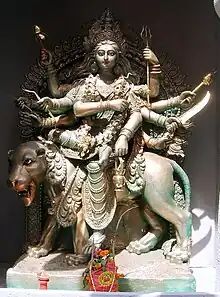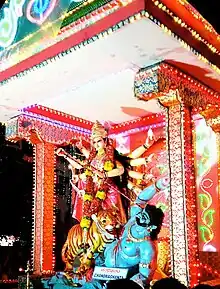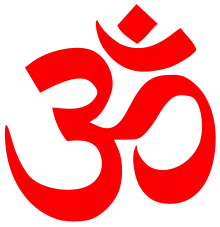| Chandraghanta | |
|---|---|
Goddess Who Fights Demons | |
 Goddess Chandraghanta | |
| Devanagari | चंद्रघंटा |
| Affiliation | Avatar of Durga |
| Planet | Chandra |
| Mantra | पिण्डजप्रवरारुढा चण्डकोपास्त्रकैर्युता। प्रसादं तनुते मह्यं चन्द्रघण्टेति विश्रुता॥ |
| Weapon | Trishul, Lotus, Gada, Kamandal, Sword, Bow, Arrow, Japa maala, Abhayamudra, Gyan mudra[1] |
| Mount | Wolf/Tiger/Eagle |
| Consort | Shiva |
In Hinduism, Chandraghanta is the third navadurga aspect of goddess Mahadevi, worshipped on the third day of Navaratri (the nine divine nights of Navadurga). Her name Chandra-Ghanta, means "one who has a half-moon shaped like a bell". Her third eye is always open, signifying her perpetual readiness for battle against evil. She is also known as Chandrakhanda, Vrikahvahini or Chandrika. She is believed to reward people with her grace, bravery and courage. By her grace, all the sins, distresses, physical sufferings, mental tribulations and ghostly hurdles of the devotees are eradicated.
Legend
According to Shiva Purana, Chandraghanta is the “Shakti” of Lord Shiva in the form of Chandrashekhara. Each aspect of Shiva is accompanied by Shakti, therefore are Ardhanarishvara.
After a performing tapas for many years Parvati married Lord Shiva. A new life begins for every woman after marriage. When Parvati visited Shiva in his home. She was whole-heartedly welcomed. The moment she entered the cave where Shiva resides, the cave was littered and all the things were misplaced. Cobwebs were the major concern. Parvati in her wedding attire took a broom and cleaned the entire cave. Days passed and Parvati was settled in her new house with new people.
While all this was happening, a new demon, Tarkasura, took root in the universe. Tarkasura has evil eyes on Shiva's family. He was bad eyeing on Parvati to cut off her actual reason for his death. He had boon as he will be only killed by the biological son of Shiva and Parvati. to create ruckus in the life of Parvati and Shiva, he assigned one demon named Jatukasura. Jatukasura is an evil bat-demon. He and his army came to attack Parvati. Unaware of all this Parvati, was busy in her daily chores. At the time, Shiva was performing intense tapa, Parvati was handling everyday work on Kailasa Parvat. Taking an opportunity of this situation, Jatukasur called a war and marched towards kailasa Parvat.
Jatukasur covered the sky with the help of the wings of his bat army. One by one all the ferocious and evil bats attacked the Shiv Gana. This frightened Parvati. Till the time these bats have created havoc and started destroying the newly decorated Paravti, Kailasa region. This angered Parvati, but she remained fearful. Parvati clicked with an idea to seek help from Nandi. So she sought Nandi, but Nandi was nowhere to be seen. Paravati's fear bloomed. After facing constant defeat, Shivgana came to Parvati and pleaded for their rescue. Parvati cried and went to where Shiva was performing his Tapa, but she was helpless. Shiva was unable to leave his Tapas. He reminded Parvathi about her inner power and that She is herself Shakti personified. He reminded her that she is the Prakriti (Srishti or the creation) herself, the mother of the universe, and that She herself is sufficient to fight and control this situation. Thus Maa Parvati decided to fight the Jatakasur.
Parvati went out in the darkness and she could hardly see. To overcome this, she needed moonlight. Paravati sought Chandradev for his support and he joined Parvathi by illuminating the battlefield. Parvati wore Chandradev as a crescent on her head during the battle. Parvati needed an army able to fight the bats in dim light. A huge pack of wolves came to Parvati's aid. The wolves attacked the bats and Parvati battled Jatakasura. After a long fight Parvati learned that the devil is energized by the bats in the sky. So Parvati brought a ghanta to the battlefield and rang it loudly, so the bats flew away. One of the wolves jumped on the Jatukasura, he growled when grounded. Then Parvati hit his head with the ghanta, cut off his wings with kide liked sword, and at last put it in his chest to kill him.
This fearsome form of Parvati, with the knife in one hand and Ghanta in the other; Moon on the forehead, and sitting on a wolf is named Chandraghanta by Brahmadev. Later Shiva told Parvati that this battle would provide anyone the courage to overcome the fear of any battle and obstacles (inner or outer). Also, no woman is weak or helpless without her man.
Form
Chandraghanta has ten hands where two hands hold a Trishula(trident), Gada(mace), bow-arrow, khadak(sword), Kamala(lotus flower), Ghanta(bell) and kamandalu (waterpot), while one of her hands remains in blessing posture or abhayamudra(Fear dispelling). She rides on a wolf as her vehicle, which represents bravery and courage, she wears a half moon depicting a Bell on her forehead and has a third eye in the middle of her forehead. Her complexion is golden. Shiva sees Chandraghanta's form as a great example of beauty, charm and grace.

Chandraghanta rides a wolf as her vehicle, however in accordance with many of the scriptures there is the mention of "Vrikahvahini", "Vrikahrudha" which refer to the wolf (Vrikah) as being ridden (Rudha) or them being seated on as (Asana) by the goddesses. This form of Devi Chandraghanta is a more warrior ready and apparently aggressive form that goddess Durga takes, however despite being adorned with the various weapons, she is also equally caring, benevolent and representes motherly qualities to her devotees. While the primary cause of this form was the destruction demons, her rather fierce depiction brings with it the encouragement that praying to her can grant one fearlessness. She is otherwise the very embodiment of serenity.
The devotees who adore and worship Chandraghanta develop an aura of divine splendor. Chandraghanta is ready to destroy the wicked, but to her devotees she is a kind and compassionate mother showering peace and prosperity. During the battle between her and the demons, the thunderous sound produced by her bell is known to have paralyzed and stunned the demons. She is ever ready to fight which shows her eagerness to destroy the foes of her devotees so that they may live in peace and prosperity.[2] Her abode is in Manipura chakra.
Prayers
Mantra
ॐ देवी चन्द्रघण्टायै नम: ॥
om̐ devī candra-ghaṇṭāyai namaḥ ॥
Dhyāna-Mantra
पिण्डजप्रवरारूढ़ा चण्डकोपास्त्रकैर्युता ।
प्रसीदं तनुते महयं चन्द्रघण्टेति विश्रुता ॥
piṇḍaja-pravarārūḍhā chanda-kopā-astrakair-yutā ।
prasidaṃ tanute mahyaṃ candra-ghaṇṭeti viśhrutā ॥
References
- ↑ "What is Gyan Mudra?". inShape. Retrieved 13 October 2017.
- ↑ "Goddess Chandraghanta". DrikPanchang. Retrieved 26 February 2015.
